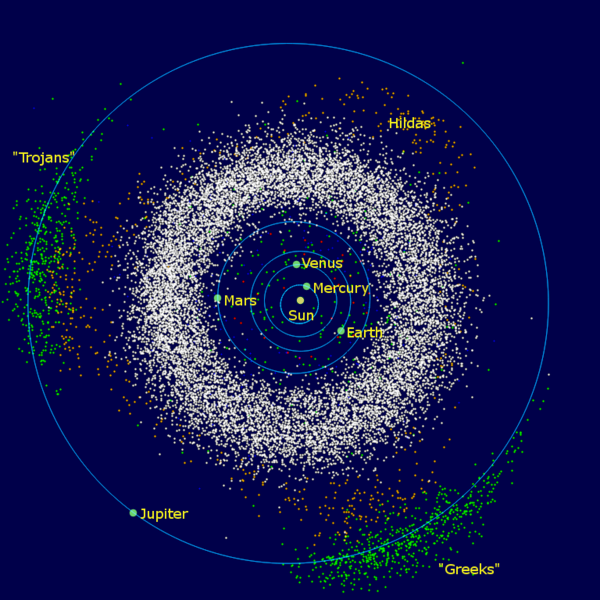
Caption: The inner Solar System plus Jupiter which is in the outer Solar System.
Features:
- The diagram is to-scale
in regard to the orbits, but
NOT in regard to the astro-bodies
which are much too big and NOT
to-scale
relative to each other.
- Besides the
inner Solar System
planets and
Jupiter, also shown are
the asteroid belt,
the Jupiter Trojan asteroids,
and the Hilda family.
- Note the asteroids look like a dense swarm which
is true in one sense.
However, their separations are usually very large relative to their sizes.
If you were on an asteroid doing naked-eye astronomy, most of the other asteroids would be unseen, except a few near ones might be star-like points of light, unless there was a fortuitous unusually close encounter with another asteroid (HI-257).
- The view is from the
north celestial pole (NCP)
side
of the Earth's orbital plane which, in
astro jargon,
is the ecliptic plane.
This is the customary
face-on
view of the Solar System.
Eastward/westward is counterclockwise/clockwise from this perspective.
- The planets
and almost all asteroids orbit
eastward which is called
prograde motion.
A very few asteroids orbit westward which is called retrograde motion.
- The astronomical unit (AU)
is the mean Earth-Sun
distance.
It is the natural unit for Solar System distances---no one grasps such distances in kilometers or miles---but the media keep quoting them mindlessly anyway.
- In astronomical units, the
mean planet-Sun
distances are as follows:
-
Mercury 0.38710,
Venus 0.72333,
Earth 1.00000,
Mars 1.00000,
Jupiter 5.20283,
Saturn 9.53876,
Uranus 19.19139,
Neptune 30.06107,
ex-planet Pluto 39.52940.
Most asteroid belt asteroids orbit in the main belt with mean orbital radii in the range 2.06--3.27 AU (see Wikipedia: Asteroid belt: Orbits).
- In astronomical units,
the Solar System size scale
is comprehensible.
- The asteroid belt is the
main reservoir of
asteroids in the
Solar System.
Gravitational perturbations by Jupiter prevented the planetesimals in the asteroid belt from coalescing into a planet in the early days of the Solar System (see Wikipedia: Asteroid belt: Formation). The asteroids evolved from those planetesimals.
Jupiter still prevents the asteroid belt asteroids from coalescing, but also somehow mostly stabilizes their orbits so that the asteroid belt has survived from the early days of the Solar System.
- A bit about
the Jupiter Trojan asteroids.
These are asteroids that cluster about the stable Lagrangian points the L4 and L5 points which are on Jupiter's orbit at points 60° ahead and 60° behind Jupiter.
The combined effect of the Sun's gravity, Jupiter' gravity, and the centrifugal force is to create the L4 and L5 points. They are stable equilibrium points in the frame rotating with the Sun and Jupiter about the mutual barycenter (i.e., center of mass) of the Sun and Jupiter .
Because the L4 and L5 points are stable, over the course of Solar System evolution wandering asteroids have accumulated near the L4 and L5 points---these are the Jupiter Trojan asteroids.
Gravitational perturbations prevent the captured asteroids from collapsing into large objects at the exact L4 and L5 points, but the restoring force that makes the L4 and L5 points stable prevents the asteroids from escaping. In particular, the restoring force prevents the Jupiter Trojan asteroids from slowly wandering along the Jupiter's orbit and colliding with or being ejected by Jupiter.
- The "Greeks" are the
leading
Trojans
and the "Trojans"
are the trailing Trojans---except
that 617 Patroclus got into the
"Trojan camp"
and 624 Hektor
got into the "Greek camp".
- The term trojan
signifies any object orbiting
near L4 and L5 points
of any planet or
moon.
For example, there are
Neptune trojans
and one known Uranus trojan.
- Occasionally,
astronomical perturbations
will inject asteroids
from the asteroid belt
and
the Jupiter Trojan asteroid zones
into orbits
within the orbit of Mars.
Such orbits
are NOT stable.
Astronomical perturbations
eventually cause
near-Earth asteroids (NEAs)
to impact
a large inner Solar System object
(Sun,
Moon,
Earth,
etc.)
or be ejected
(often by what can be called
gravity assists)
out of the inner Solar System
on the time scale of a few million years
(see Wikipedia:
Near-Earth object: Near-Earth asteroids (NEAs)).
See N-body simulation videos for impact events and gravity assists.
Image link: Wikipedia: File:InnerSolarSystem-en.png.
Local file: solar_system_inner.html.
File: Solar system file: solar_system_inner.html.